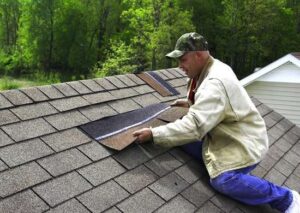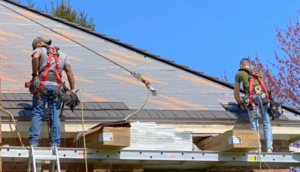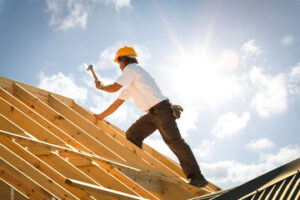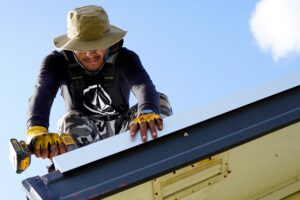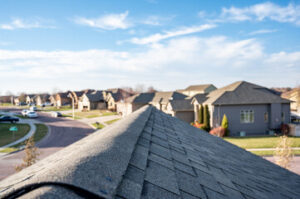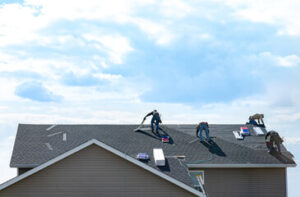Working as a roofer is demanding and requires a lot of physical stamina. Having good problem-solving skills and being comfortable working on high surfaces is also important.
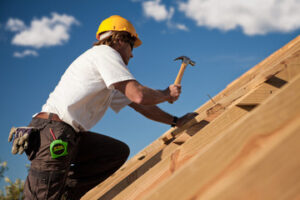
Commercial roofers install and repair roofs in offices, shops, etc. They ensure the roofs are sturdy and safe for everyone entering these establishments.
Commercial roofers are responsible for installing, repairing, and replacing roofs on commercial establishments. Their primary duties include inspecting a building’s roof, assessing damage, and conducting repairs to ensure the structure is sturdy and safe for its occupants. They must also communicate with establishment owners to inform them of any issues with the roof and provide recommendations on how to address them. Since commercial roofs are designed using different specifications than residential ones, only a qualified professional will be able to construct a durable and long-lasting roof for the establishment.
Roofing is one of the most important parts of a building, and it should be done properly to avoid leaks, water damage and other problems. That’s why it is important to choose a local roofer with the proper licensing, insurance and experience. A licensed roofer will be able to provide you with the best quality service at an affordable price.
Licensing requirements for commercial roofers differ depending on the state in which you live. For example, some requires a contractor to be licensed in order to perform roofing work. Applicants must pass the Construction Contractor or Residential Specialty Contractor License exam, and provide proof of insurance and a surety bond to become licensed. Additionally, they must complete pre-licensing training to qualify for the exam.
In Idaho, roofers are required to register with the Contractors Board. Besides this, they must have a business license and carry workers’ compensation and general liability insurance to qualify for registration. In addition, roofers should have at least three years of experience working on a commercial project.
Roofers are required to obtain a contractor’s license from the state’s Construction Industries Division. They can apply for a Restricted License or an Unrestricted License, depending on their work experience and qualifications. They must also pass a trade and law exam to become licensed.
The roofer’s credentials should be clearly displayed on their website. It is also recommended that they join a trade organization to further enhance their credibility and demonstrate their commitment to the industry. This will help them stand out from other competitors and attract more clients.
Insurance
Roofing contractors have unique insurance needs that require different policies than other business owners. Typically, roofers need commercial general liability and workers’ compensation coverage, along with additional policies that are specific to the roofing industry, such as business interruption, umbrella and professional liability. Getting the right policies is essential for your roofing company’s success.
General liability insurance is critical for roofers because it protects them in the event that third-party property damage or bodily injury occurs while they are working on a project. For example, a nail or other debris from a roofing job could hit someone who is walking by the site and cause injury. If that happens, the roofer’s general liability policy may pay for medical costs and a victim’s compensation.
It’s also possible that the roofers themselves can become injured on the job. If that occurs, workers’ compensation insurance helps cover treatment expenses, loss of wages, and even death benefits. If you’re a commercial roofer, it’s likely that your state or province requires you to carry this type of insurance for your employees.
In addition to worker’s comp, a roofer should consider carrying general liability, commercial auto, and builder’s risk insurance. Builder’s risk insurance is necessary for construction projects that are ongoing and can be damaged by fire, explosion, weather, vandalism, and theft. This is especially important for large, complex jobs that involve the use of multiple layers of shingles and other materials.
Commercial auto insurance is required if the roofer uses his or her own vehicle for business purposes, such as hauling tools and equipment to work sites. Personal auto insurance won’t usually cover those kinds of damages, so this is an important additional policy to carry. Commercial auto insurance also provides for the same type of coverage if the roofer uses a company vehicle to transport clients or to visit potential customers.
Errors and omissions insurance (also called professional liability) may help pay for legal fees and other costs if a client sues over faulty advice or recommendations that led to financial loss. This policy is recommended for any professional who gives advice and recommendations that could lead to a loss of money for the client. A surety bond, which is not technically an insurance policy, is another option for a roofer. This provides a guarantee that the roofer will finish a job after he or she has accepted it from a customer.
Experience
The roofing industry is on a steady growth trajectory, with projected increases in employment opportunities. As a result, many people are interested in learning how to become roofers. While it can be a challenging career, there are several ways to get started in this field. One way is to complete a roofing apprenticeship program with an experienced commercial roofer. These programs provide a comprehensive education in the field of roofing, including decoding building blueprints, math, and general troubleshooting skills. In addition, they provide hands-on experience working on actual construction sites.
The requirements for becoming a commercial roofer vary, but most of them require a strong work ethic and a willingness to learn. They must also be comfortable with heights, as they frequently work at very high heights and must be able to navigate ladders and scaffolding safely. They should also be able to handle physical demands, such as lifting heavy objects and working in awkward positions for extended periods of time.
A commercial roofer should also have a thorough understanding of local building codes and compliance regulations. This will help them ensure that their work is up to code and that their clients’ buildings are protected from the elements. They should also be able to understand how different roofing materials can impact water drainage and structural integrity.
In addition to roofing installation, commercial roofers also need to be familiar with roof repair and maintenance. They must be able to identify problems, determine the best course of action, and follow up on the completion of repairs. They also need to be able to communicate effectively with their clients and other contractors.
When choosing a commercial roofer, look for a contractor with a proven track record of success. You can usually find this information on a company’s website or by asking them directly. Moreover, you should always request photos or examples of their previous roofing projects. This will give you an idea of the quality of their work and whether or not they are a good fit for your project. Also, make sure to check that they are certified by the manufacturer of the roofing system you want to use.
References
When selecting a commercial roofer, you want to make sure they have the proper licenses and insurance. Not only will this protect you as the property owner, but it will also ensure that they are following state and local regulations for working on your building. Make sure you ask for a copy of their current insurance certificate before hiring them to work on your roof. This will allow you to compare their insurance coverage against competitors and make an informed decision.
Commercial roofers are experts in constructing and maintaining roofs for commercial buildings, such as warehouses, shopping centers, office buildings, and more. While they may share some carpentry skills with residential roofers, they tend to have different skill sets. Commercial roofs typically have a much more complex structure than residential roofs, and they are constructed from different materials.
A good commercial roofer should be able to provide you with a list of references from past customers who worked with them on roofing projects. When you call the references, you should ask about their overall experience with the contractor and if they would hire them again for future jobs. In addition, you should ask about the quality of the roofing job and if the contractors kept to their estimated timeframes and budget.
Ideally, you should choose a roofing contractor who has completed several projects for previous clients. This will help you determine their level of expertise and how well they manage different types of projects. Additionally, you should request details about the scope of the project and what is required from the building owner in terms of access, storage for equipment and supplies, customer/employee parking, etc.
You should also ask the roofer’s references about their workplace habits and whether they were professional and easy to communicate with. This will give you an idea of how they will handle your project and what to expect from them.


